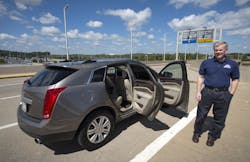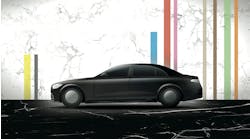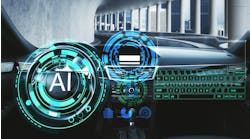A 2015 study released by consulting firm McKinsey & Company reported that self-driving vehicles could eliminate 90 percent of all auto accidents in the U.S. and that there will be mass adoption to auto-piloted vehicles in about 15 years. With a potentially drastic change coming to the collision repair industry, John Dolan, principal systems scientist at Carnegie Mellon University's Robotic Institute, says it’s important for shop owners to pay attention. Not all collisions will be eliminated, Dolan adds, but the presence of advanced sensors in the body of a vehicle will impact what technicians will need to be familiar with and will change the nature of repairs. These repair changes are what makes it important for those in the collision industry to stay up-to-date on the latest news in autonomous technology.
In November, CMU celebrated 30 years of autonomous vehicle research. Dolan, who attended grad school there from 1985–1991 for his master’s and Ph.D., remembers working on a self-driving car that was able to follow an asphalt path at CMU when he was a grad student. Since then, Dolan has watched the university develop some of the foundations for self-driving technology, create 14 generations of self-driving cars and has watched a number of his students and colleagues go on to work for self-driving initiatives at high-profile companies like Uber and Google.
Although Dolan says it's been difficult to lose some talent to powerhouse companies, the university isn’t slowing down. In fact, it is keeping pace with them. It was recently announced that CMU’s spinoff, Ottomatika, which was acquired by Delphi in 2015, aims to create a computer chip that will deliver a production-ready fully autonomous system by 2019. Delphi, Mobileye and Intel announced a partnership in December that will use self-driving algorithms developed by Ottomatika to help develop autonomous vehicles. In January, the partners demonstrated the vehicle at the 2017 Consumer Electronics Show. With the race toward autonomy in full force, universities like CMU are gaining momentum.
What should collision repair shop owners expect to see self-driving cars become more and more prevalent?
Our goal with this technology is to reduce collisions, which could be bad for business. It’s difficult because although it will impact business for collision repair shops, I think we’d all agree that we’d rather have cars never run into one another. However, it will be difficult to eliminate that entirely. The sensors that are being developed will have the ability to lessen the extent of the damage. It’s possible that the sensors will have the intelligence to strike at a point where there’s not as much damage done to the vehicle or they may have the ability to react at a rate that humans are not capable of and reduce the speed. Collision repairers will need to gain an understanding of the sensors that are being embedded into these vehicles and have knowledge of how to repair those. They are going to need to be able to take self-driving car components and restore or calibrate them.
How have you seen technology change in your time at CMU?
I think one of the biggest changes is the miniaturization of electronics and computers. When I was a grad student working on the self-driving cars, some of the computers we used had to be off-board. With the earlier self-driving cars that we developed, there had to be a lot of space to hold all of the bulky computers and sensors we were using. Now, we have computing power that’s compact.
2019 isn’t far off; how confident is CMU that it will develop the computer chip technology that it announced for that time?
It’s important to remember that it’s a chip. That doesn’t mean everything will be ready by 2019. There have been a lot of announcements but it’s important to listen to what specifically is being described. Will it be available just on the highway or in the city? Highway driving is easier. There’s visible lane marking, so the system is basically just following a ribbon or a thread. You don’t have to worry about pedestrians running out in front of cars on the highway. I think it’s reasonable for us to say that we’ll have autonomous driving by 2019 or 2020 on the highway. However, even then, I don’t think it will be Level 4 autonomy where the driver can fall asleep or read a book.
If cars won’t really be able to operate without someone in the vehicle, what’s the significance of a milestone like that?
Achieving these capabilities will give consumers the experience to gain confidence so when the time comes, they are ready. This will also give us at CMU the ability to gather data about the range of problems in the system that will help accelerate the data. There have been two fatalities associated with autopilot already, which is unfortunate. It’s important to remember there were fatalities when flight was being tested. At CMU, we are dedicated to making it as safe as possible, which is why we’re gathering as much data as possible.




